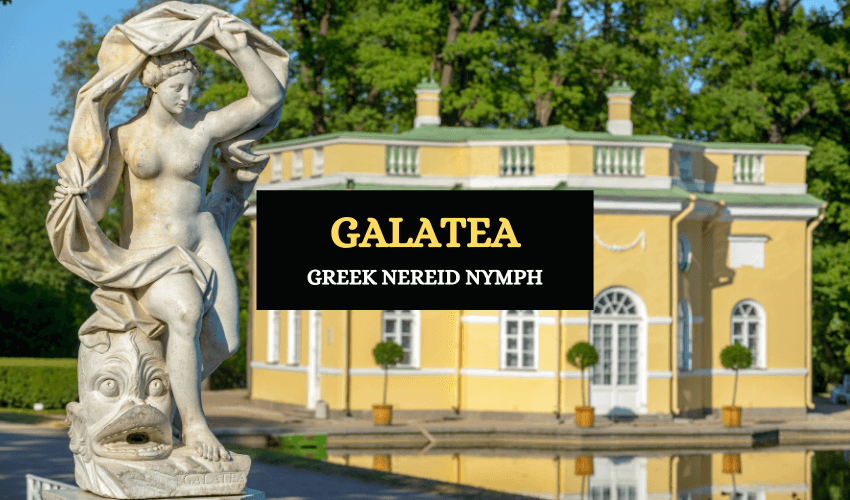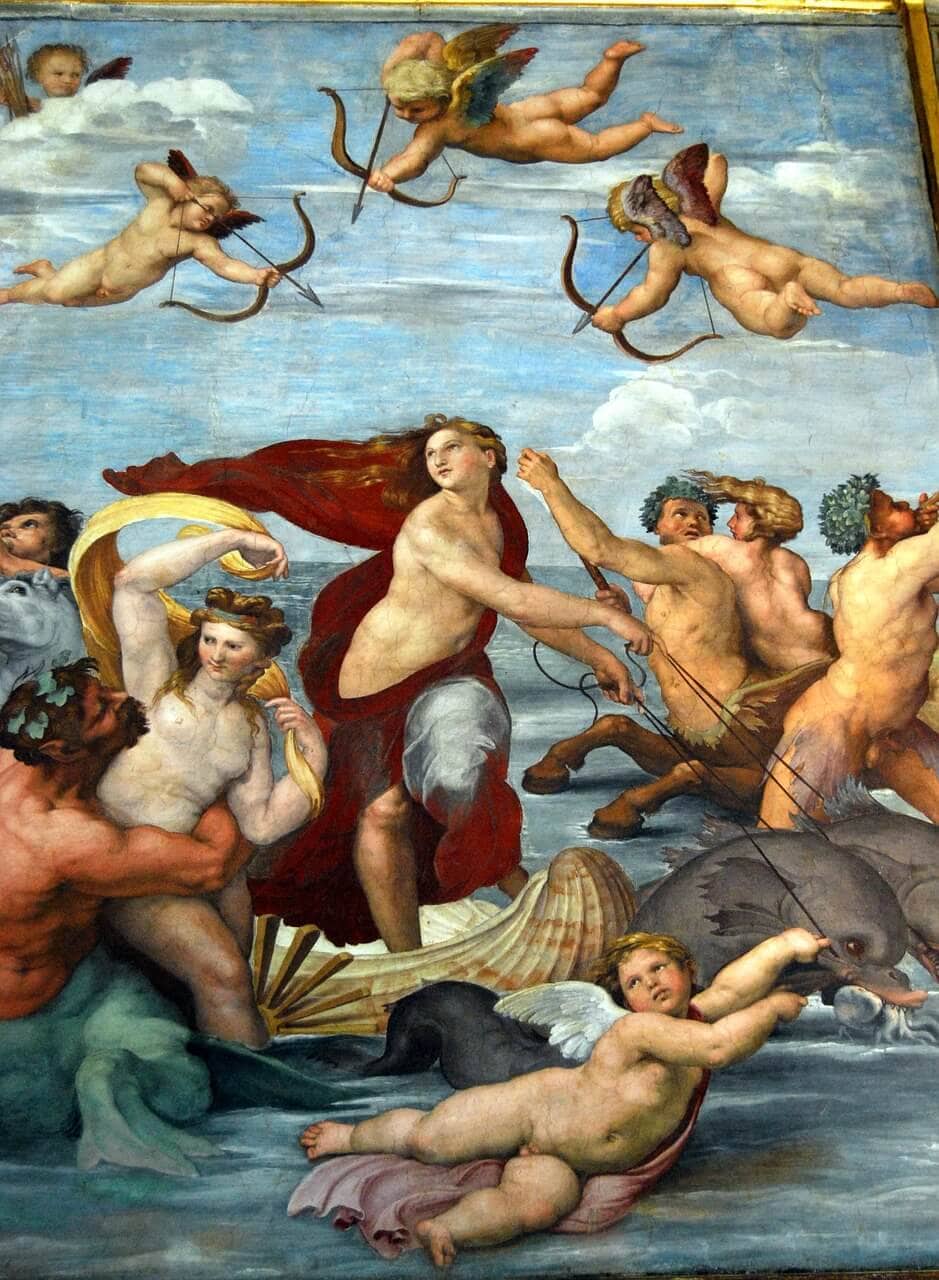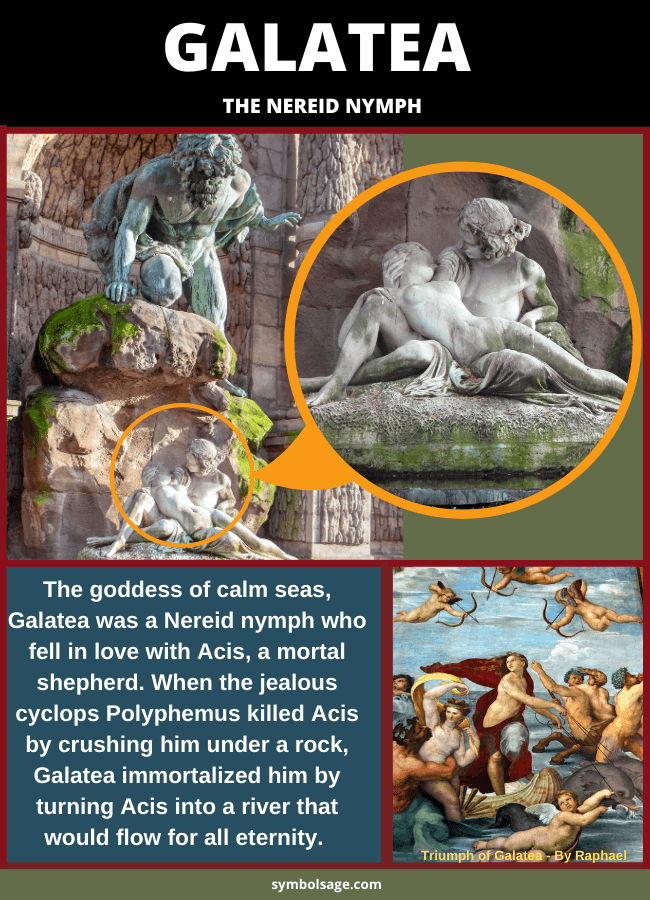
Table of Contents
In Greek mythology, Galatea was a Nereid nymph, one of the many daughters of the sea god Nereus. Most people tend to think of Galatea as a statue that was brought to life by the goddess Aphrodite. However, two Galateas are said to be two completely different characters in Greek mythology: one a nymph and the other a statue.
Known as the goddess of the calm seas, Galatea is one of the minor characters in Greek mythology, appearing in very few myths. She’s known mostly for the role she played in one specific myth: the story of Acis and Galatea.
The Nereids
Galatea was born to Nereus and his wife Doris who had 49 other nymph daughters called the ‘Nereids’. Among Galatea’s sisters were Thetis, the mother of the hero Achilles, and Amphitrite, the wife of Poseidon. The Nereids were traditionally thought of as Poseidon’s retinue but also often guided sailors who were lost on the Mediterranean Sea.
In ancient art, Galatea was depicted as a beautiful woman on the back of a fish-tailed god, or a sea-monster which she rode side-saddle. Her name means ‘milk white’ or ‘the goddess of the calm seas’ which was her role as a Greek goddess.
Galatea and Acis
The story of Galatea and Acis, a mortal shepherd, took place on the island of Sicily. Galatea spent most of her time on the island shores and when she first saw Acis, she was curious about him. She observed him for several days and before she realized it, she had fallen in love with him. Acis, who thought she was divinely beautiful, subsequently fell in love with her as well.
The island of Sicily was the home of the Cyclopes and Polyphemus, the most famous of them, had fallen in love with the goddess of the calm seas as well. Polyphemus was an ugly giant with a single huge eye in the middle of his forehead and Galatea, who thought him unsightly, rejected him at once when he expressed his love to her. This made Polyphemus angry and he was jealous of the relationship between Galatea and Acis. He decided to get rid of his competition and chased Acis, picking up a large stone and crushing him to death with it.
Galatea was overcome with grief and mourned for her lost love. She decided to create a memorial to Acis that would stand for eternity. She did this by creating a river from his blood. The river flowed around the famous Mount Etna and ran straight into the Mediterranean sea which she called ‘River Acis’.
There are several renditions of this story. According to some sources, Galatea was enamoured by Polyphemus’ love and attention. In these versions, he’s described not as an ugly giant but as someone who was kind, sensitive, good-looking and was able to woo her.
Cultural Representations of Galatea

The story of Polyphemus pursuing Galatea became highly popular among Renaissance artists and there are several paintings which depict it. The tale has also become a popular main theme for movies, theatrical plays and artistic paintings.
The Triumph of Galatea by Raphel depicts a scene later in the Nereid’s life. Galatea is depicted standing in a shell chariot, pulled by dolphins, with a triumphant look on her face.
The love story of Acis and Galata is a popular subject in operas, poems, statues and paintings in the Renaissance period and after.
In France, Jean-Baptiste Lully’s opera ‘Acis et Galatee’ was dedicated to Galatea and Acis’ love. He described it as a ‘pastoral-heroid work’. It depicted the story of a love-triangle between three main characters: Galatea, Acis and Polipheme.
Frideric Handel composed Aci Galatea e Polifemo, a dramatic cantanta that emphasised Polyphemus’ role.
There are several painting featuring Galatea and Acis, group according to their different themes. In almost all the paintings, Polyphemus can be seen somewhere in the background. There are also some that feature Galatea on her own.
Sculptures of Galatea
From the 17th century onwards in Europe, sculptures of Galatea began to be made, sometimes depicting her with Acis. One of these stands near a pool in the gardens of Acireale, a town in Sicily, where Acis’ transformation was said to have taken place. The statue depicts Acis lying beneath the boulder that Polyphemus used to kill him and Galatea crouches to her side with one arm raised up to the heavens.
A pair of statues sculpted by Jean-Baptise Tuby located in the Versailles gardens shows Acis leaning on a rock, playing a flute, with Galatea standing behind with her hands lifted up in surprise. This gesture is similar to another statue of Galatea alone at the Chateau de Chantilly.
There are many statues that feature Galatea alone but there have been incidents where people have mistaken her for Pygmalion’s statue, also named Galatea. The main difference between the two is that the nymph Galatea is typically depicted along with sea imagery including dolphins, shells and tritons.

In Brief
Although she’s one of the minor characters in Greek mythology, Galatea’s story is quite well known and has captured the attention of people from all over the world. Most look at it as a tragic story of undying love. Some believe that to this day, Galatea stays by the River Acis, mourning for her lost love.








